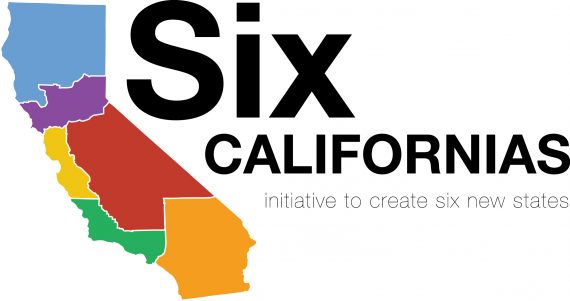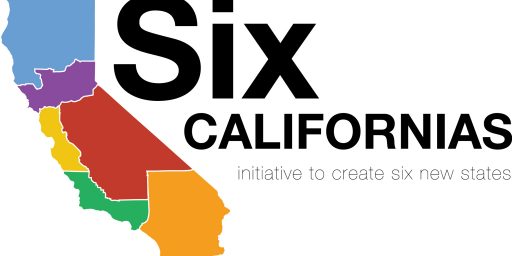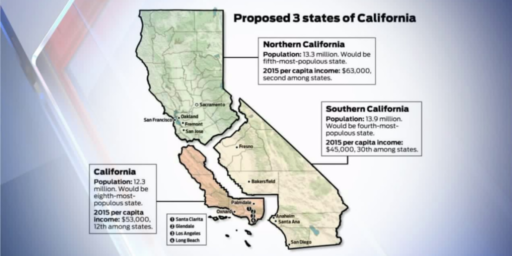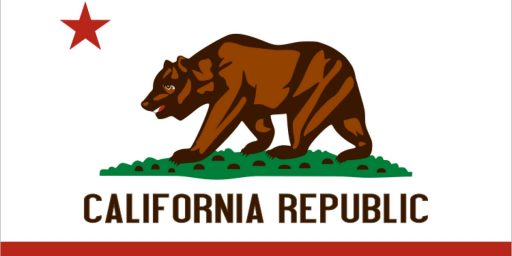Initiative To Break California Into Six States Fails To Make Ballot
A ballot initiative that would have put the question of splitting California up into six separate states has failed to qualify for the ballot:
A proposed ballot measure to carve California into six states failed to qualify for the November 2016 ballot Friday after election officials determined that backers did not collect enough valid signatures.
The outcome is a blow to billionaire Tim Draper, the Silicon Valley venture capitalist who spent $5.2 million to put his “Six Californias” idea before voters. He had said the measure would bring government closer to the people and make it more responsive, but critics said the proposal hurt the state’s image and would be unworkable if approved.
The measure needed 807,615 valid voter signatures to qualify, and the Six Californias campaign turned in nearly 1.14 million in mid-July. But several weeks of random signature checks that ended Friday determined that only 752,685 signatures were valid – almost 15,000 signatures below the threshold needed to launch a full count of every signature.
In a statement, Draper said he is convinced that the campaign turned in enough valid voter signatures to qualify his measure. He said the campaign will review signatures deemed invalid in several counties, noting that the campaign’s signature-gathering firm had projected that many more signatures would be valid than did election officials.
“It is yet another example of the dysfunction of the current system and reinforces the need for six fresh, modern governments,” Draper said. “In the meantime, we will work with the secretary of state to verify all of the signatures gathered during the petition process.”
Six-state opponents called on Draper to “move forward from this failed proposal and join in focusing on the needs of our one Golden State.”
“Six Californias was a solution in search of a problem that didn’t address any of our state’s challenges,” said former Assembly Speaker Fabian Núñez, the chairman of the One California group opposing the measure. “The implosion of this ballot measure spares us from a two-year campaign of bashing our great state, which continues to be the nation’s bastion of innovation, diversity and progress.”
I am not familiar with California’s election procedures, so it’s unclear if Draper has an avenue for appeal here, or whether his organization could attempt to do the signature drive again before 2016 in order to get on the ballot. However, this is obviously a significant setback for an initiative that didn’t seem to have much support to begin with, and which probably never would have worked even it had gotten enough votes. As I noted when I wrote about this in July, there was a strong argument that the initiative would violate state law, which prohibits revisions to the state Constitution from being the subject of a referendum. Additionally, as a practical matter it the scheme would run up against the fact that the Constitution would require both the California legislature and the United States Congress to agree to the plan, which seems unlikely for a whole host of reasons.
So, for now at least, we won’t been seeing the states of North California, South California, Central California, West California, Silicon Valley, and Jefferson. And it seems unlikely that we ever will either.







Toldja so.
I’ve never really seen this thing as very serious, not the least because of the legal issues noted above.
It does surprise me, though, that so many of their signatures turned out to be invalid.
This was a very thinly disguised attempt to create 3 low population Republican states out of one Democratic state. I’m both surprised and pleased that it did not make the ballot.
@Doug Mataconis:
I think the obviously silly nature of the proposal is responsible for the large number of joke signatures.
@al-Ameda:
Actually the initiative was backed by a Silicon Valley VC guy. As I noted in my original post, Silicon Valley stood to benefit the most economically from this scheme. That’s what it was all about.
Thanks for sharing your thoughts on california. Regards
@Doug Mataconis: So noted Doug, however the practical effect would have been to create 3 new Republican states, and 6 GOP Senators out of 1 State and zero Republican senators. Also, the Silicon Valley state would probably be Democratic oriented, the northern, central valley and eastern CA stated would be Republican and are lower population areas – Draper’s initiative would have diluted the power of the high population areas and increased power to the lower population areas. This is analogous to creating more Wyomings to offset the California’s, the effects are obvious in the senate, not quite as much in the house.
@al-Ameda: I think you and Doug are both partly right. Yes, it would have created 3 new Republican states (I think “Northern California” might actually have leaned Democratic–Marin/Sonoma & Sacramento outweighing the yahoo counties–while “Southern California would have been solid Republican–Orange County, San Diego, and the Inland Empire–but the net effect is the same). But I also think Draper wanted the tech-billionaire overlords to have their own little state to play with.
@Doug Mataconis:
This would have surprised you less if you lived in California. They use paid signature gatherers, who typically stop people outside grocery stores and the like asking them to sign an initiative, or more commonly several initiatives. They get paid a certain amount per signature, last I heard it was $1. The gatherers have no incentive to verify that the signers are registered voters or that they haven’t signed before. As a rule, a/3 of the signatures, at a bare minimum, will be disqualified because of duplicates, invalid registration information, or whatever. This one was notorious enough that I’m sure it attracted a lot of “malicious mischief” signatures or signatures from non-registered voters who were doing purely for a joke.
@al-Ameda: It would have increased the influence of the people of all six putative states. It’s just that spoke would have seen more benefit than others. It would have diminished the influence of all remaining 49 states, big and small.
As I’ve noted before, Alaska was initially a hard Democratic state, and part of the reason that Hawaii was accepted as a state was to offset it with its firm Republican vote. Don’t get caught up in the short-term “color” vote counting.
@Pinky: Also, there was some reluctance on the part of Democrats to admit a host of states (WA, ID, MT, WY, ND, SD) because they were figured to be Republican states. They were actually populist strongholds, two voting for People’s Party’s James Weaver in 1892 and four of the six states going for William Jennings Bryan by 1896.
@Kari Q: That, or the paid signature collectors just sign “Mickey Mouse” a bunch of times. Newt Gingrich, in the 2012 presidential election, wasn’t able to make the Republican primary ballot in Virginia because of rampant fraud by his signature collector:
http://www.salon.com/2013/06/19/virginia_man_pleads_guilty_to_forging_newt_gingrich_primary_signatures/
Splitting California is tricky, because while there are two population zones, there’s also the Central Valley with its own culture and issues. I don’t see CA ever getting split into more than two states. So who gets the Central Valley? Or if you split it, how? Maybe you just draw a line.
It’s not really worth discussing, Pinky, since the state is never going to split at all.
It’s still fun to think about. I think splitting California three ways instead of two makes more sense.
To ensure that your choice is right, make an assessment if
the health center that you are going to choose is affiliated to the local health department.
There is no substitute for having all the diagnostic
information. In the worst case, there may be no educational requirement at all to become a member and the
dentists need know nothing about placing dental implants.
I had never thought about the “stacking the Senate” as it were that would probably have resulted in this in the Republican’s favor. It certainly is an interesting – and nefarious – motive.
At the same time, isn’t there an argument to be made that creating these states would indeed increase accurate representation of the people in those areas? I definitely see a slippery slope here – next do we split Texas up so that the Austin area can elect Democrats? I suppose this is like the great debate about gerrymandering, which has apparently allowed more blacks to be voted in because they have been gerrymandered into minority districts, but at the same time it has increased the security of all districts so that no one is really being challenged, and no consensus need be built.
I find all these issues interesting, but I don’t pretend to be an expert. It just seems like there are valid arguments on both sides, but I think I would prefer to see less gerrymandered districts.